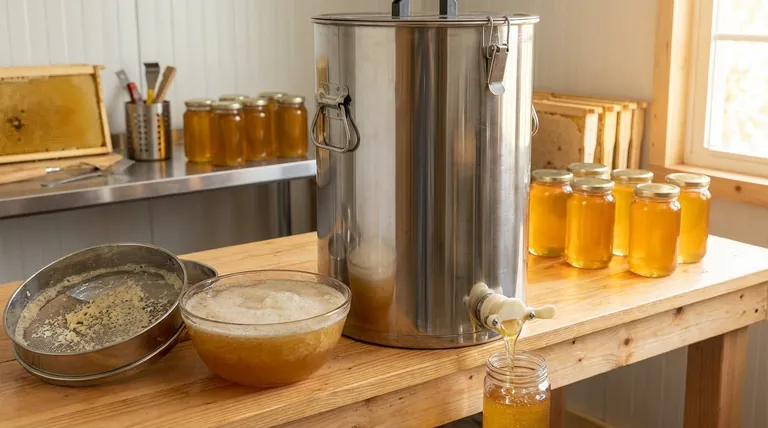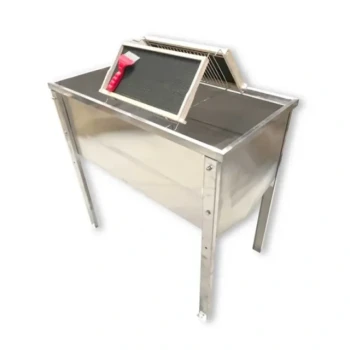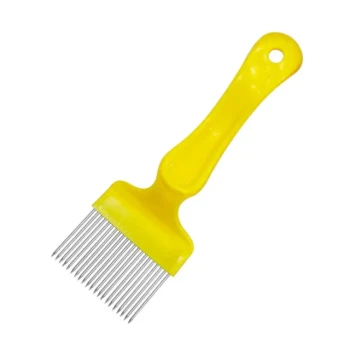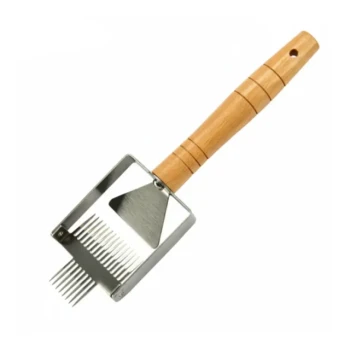In most cases, honey requires approximately two to four days to settle properly after extraction. This resting period is not arbitrary; it is a critical step that allows microscopic air bubbles, fine wax particles, and other light debris to naturally rise to the surface, resulting in a clear, stable, and visually appealing final product.
The time it takes for honey to settle is less about a fixed schedule and more about achieving a specific outcome: separation. While a few days is a reliable benchmark, the exact duration depends on temperature, which directly controls the honey's viscosity.

The Purpose of Settling Honey
After honey is extracted from the comb, it is often cloudy and turbulent. The settling process, also known as clarifying, is designed to resolve this by allowing gravity to do its work.
Releasing Trapped Air Bubbles
The primary cause of cloudiness in fresh honey is air. The process of spinning honey in an extractor or even just filtering it whips countless tiny air bubbles into the liquid, making it appear opaque or foamy. Settling gives these bubbles time to slowly migrate to the surface.
Separating Fine Particulates
Even with careful filtering, microscopic particles of beeswax, pollen, and other hive material can remain suspended in the honey. During the settling period, these fine particulates will also rise to the top along with the air bubbles, forming a distinct layer of "scum" or foam.
Achieving Final Clarity and Quality
The end goal is to produce honey that is brilliantly clear and free from imperfections. Bottling honey before it has fully settled will result in an inferior product, as bubbles and foam will eventually form at the top of the jar, which can be unappealing to consumers.
Factors That Influence Settling Time
"A few days" is a guideline, but several factors can significantly speed up or slow down the process. Understanding them gives you control over the outcome.
Temperature and Viscosity
This is the single most important factor. Honey is highly viscous (thick and resistant to flow). Warmer honey is less viscous, allowing bubbles and particles to rise much more quickly. Cold honey can take a week or more to settle, while honey kept in a warm room (e.g., 85-95°F / 30-35°C) may settle in just 24-48 hours.
Container Shape
The distance particles need to travel matters. A tall, narrow settling tank is more efficient than a short, wide one. In a taller container, bubbles have a shorter horizontal path to travel before they can rise upwards, speeding up clarification.
The Extraction Method
A high-speed centrifugal extractor will incorporate significantly more air into the honey than a gentle "crush and strain" method. The more air that is introduced, the longer the settling time required to release it all.
Understanding the Trade-offs
Optimizing for speed without understanding the consequences is a common pitfall.
The Risk of Rushing the Process
The most common mistake is bottling too soon. If you bottle cloudy honey, the air will still separate later, creating a layer of foam at the top of each individual jar. It is far more efficient to skim one large settling tank than to have hundreds of jars with imperfections.
The Problem with Excessive Heat
While warmth is beneficial, too much heat will ruin your honey. High temperatures (above 105°F / 40°C) can destroy the delicate enzymes and volatile aromatic compounds that give honey its unique flavor and health benefits. Use a gentle, controlled heat source in a dedicated warming cabinet or small room, never direct heat.
The Settling and Skimming Process
Follow these steps for a professional-grade result.
Step 1: Transfer to a Settling Tank
After extraction and initial filtering, pour the honey into a food-grade settling tank. These are often bottling buckets equipped with a honey gate (a type of valve) near the bottom. The gate allows you to decant the clear honey from below the surface foam.
Step 2: Let It Rest
Cover the tank with a lid or cloth to prevent dust from getting in. Place the tank in a warm, undisturbed location for at least 48 hours. The warmer the room, the faster this will go.
Step 3: Skim the Surface
Once a clear layer of foam and wax has formed, it must be removed. You can use a large spoon or spatula to carefully skim it off. A more effective method is to gently lay a sheet of plastic cling film directly onto the surface of the honey, then slowly peel it back. The foam and wax will adhere to the plastic, leaving a pristine surface behind.
Making the Right Choice for Your Goal
Use these guidelines to tailor the process to your specific needs.
- If your primary focus is maximum clarity and quality: Settle the honey for 48-72 hours in a warm room (85-95°F / 30-35°C) before carefully skimming the top.
- If your primary focus is speed for a small batch: Warming the honey for 24 hours can be sufficient, but be prepared to skim diligently and accept that some micro-bubbles may remain.
- If you are bottling raw, unfiltered honey: Settling is still vital for removing the majority of air from extraction, but the final product will intentionally remain cloudy with pollen and fine wax.
Patience during the settling stage is the final step in producing truly exceptional honey.
Summary Table:
| Factor | Impact on Settling Time | Key Consideration |
|---|---|---|
| Temperature | Warmer (85-95°F) speeds up; colder slows down | Avoid excessive heat (>105°F) to preserve quality |
| Container Shape | Tall, narrow tanks are more efficient | Reduces horizontal travel distance for bubbles |
| Extraction Method | High-speed extractors add more air, increasing time | Gentle methods like crush and strain are faster |
Produce Honey of Exceptional Quality and Clarity
For commercial apiaries and beekeeping equipment distributors, achieving a perfect, clear final product is essential for customer satisfaction and brand reputation. HONESTBEE supplies the professional-grade settling tanks, honey gates, and warming equipment you need to streamline your process and maximize efficiency.
Let us help you optimize your honey production. Contact our wholesale experts today to discuss your specific needs and scale your operation.
Visual Guide

Related Products
- Stainless Steel Honey Storage and Settling Tank with Double Strainer
- Professional Honey Storage Tank with Agitation System
- Stainless Steel Heated Honey Tank Warming Heating Tank
- Stainless Steel Honey Storage Tank with Lid for Honey
- Stainless Steel Uncapping Tank with Stand and Strainer
People Also Ask
- What type of tank is used in the honey drying process? Master Gentle Moisture Removal for Premium Honey
- What is the purpose of a honey storage tank? Streamline Your Honey Processing for Quality & Efficiency
- Can I store honey in stainless steel? A Guide to Safe, Long-Term Honey Storage
- How long to leave honey to settle before bottling? Achieve Perfect Clarity in 48 Hours
- How long do you leave honey to settle? The 48-Hour Rule for Perfectly Clear Honey



















